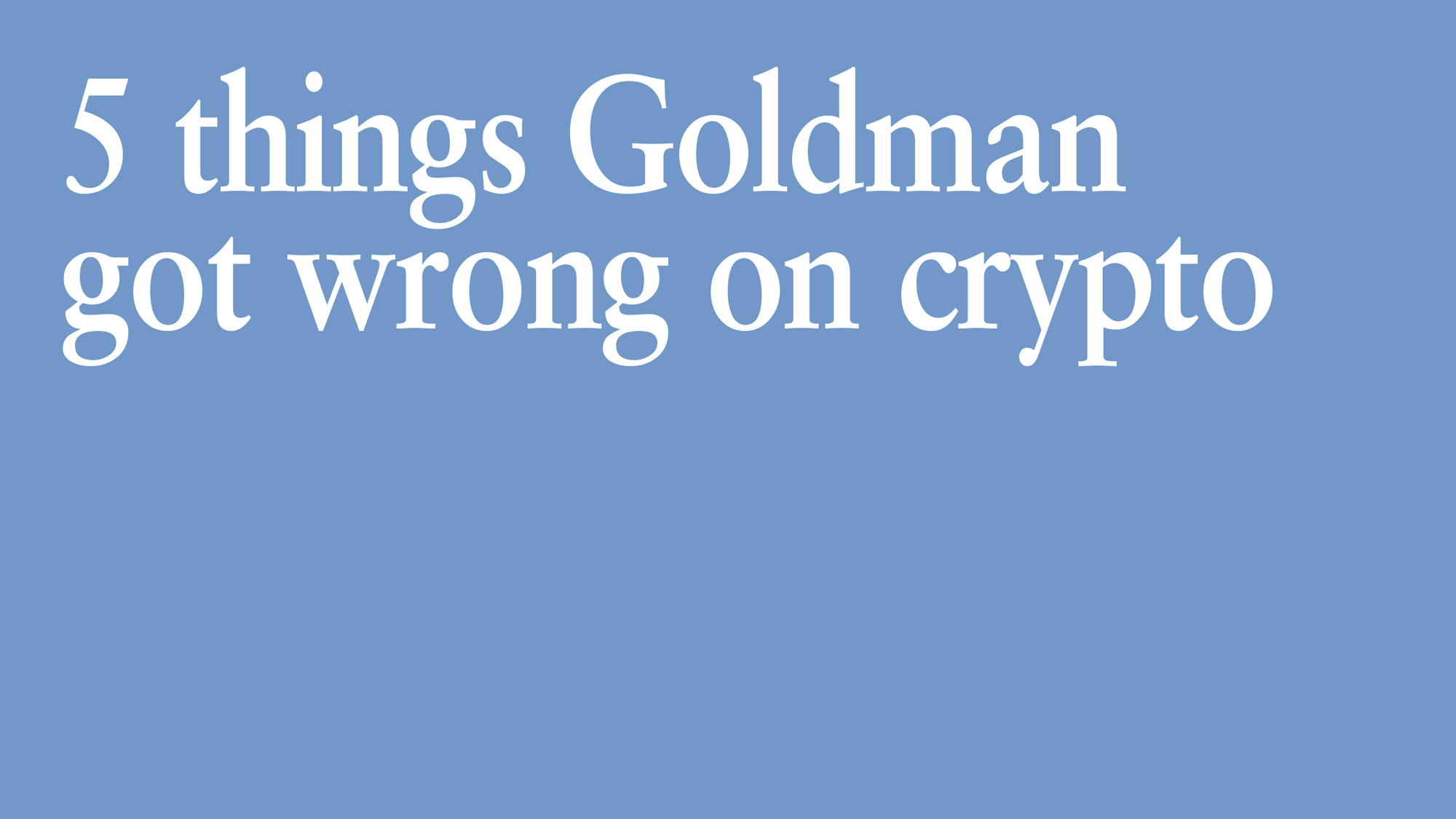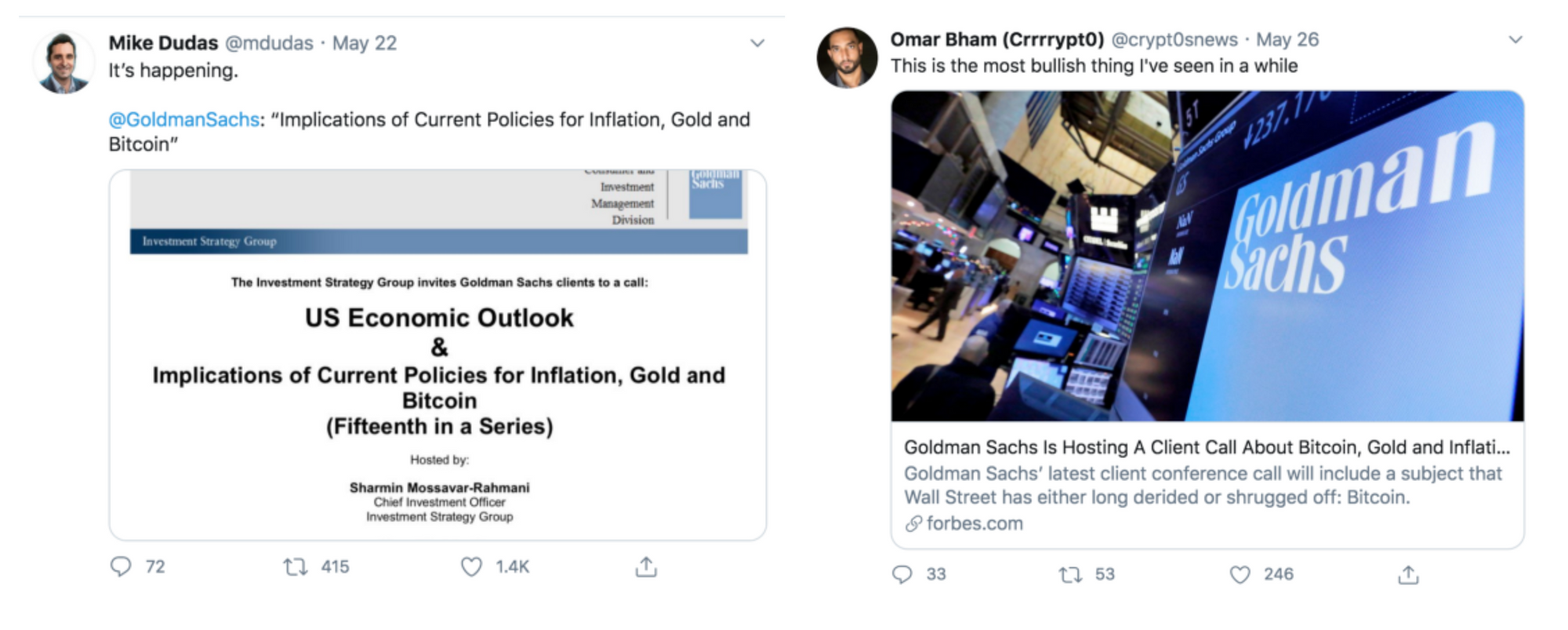5 things Goldman Sachs got wrong on crypto

A casual observer might be surprised to learn that Goldman Sachs has held an opinion on bitcoin and cryptocurrencies. As early as March 2014, a Goldman put out a report that suggested, “bitcoin likely can’t work as a currency, but … the ledger-based technology that underlies it could hold promise.” In the heat of the bull market of 2017 and 2018, Goldman Sachs flipped their opinion and put out a 9 page report entitled “Bitcoin as Money” where they concluded that in theory, bitcoin could succeed as a form of money, particularly in emerging markets.
In fact, they were so excited about bitcoin that at the time they were considering launching a bitcoin trading desk — a move proclaimed to be a massive step forward for Wall Street’s adoption of the asset class. The story became an instant media hit as finance executives left Wall Street for crypto and bank analysts predicted record highs for bitcoin.
That sentiment was short-lived, however. After the collapse of the crypto market in 2018, Goldman released another report entitled “(Un)Steady As She Goes” which famously stated “We expect further declines in the future given our view that these cryptocurrencies do not fulfill any of the three traditional roles of a currency.” The crypto market fizzled out, Wall Street seemed to lose interest, and Goldman Sachs abandoned plans to open a bitcoin trading desk.
Fast forward to May 2020, and Goldman is back again with another report on bitcoin and cryptocurrencies.
Goldman Sachs’ most recent crypto report
Last Wednesday, Goldman Sachs held an investor call to discuss their policies for bitcoin, gold, and inflation in the context of the coronavirus pandemic and current economic climate. Covid-19 has led to an unprecedented global economic crisis and financial market turmoil, with the IMF calling it the worst recession since the Great Depression. Unemployment is skyrocketing, companies are missing their earnings statements, and traditional investments are taking a hit across the board. Investors worldwide are scrambling to find safe havens to park their assets. Bitcoin, on the other hand, has fully recovered fully since the March 12 crash.
The call was first announced to Goldman clients two weeks ago, and on the heels of growing momentum from mainstream financial institutions, had many in the crypto community expecting bullish sentiment. Could it be that the stalwart bank was going to signal to the rest of the world that recent economic events due to Covid-19 have finally persuaded them to endorse bitcoin as a hedge against inflation? The crypto world was beyond excited, and bitcoin’s price spiked nearly 5% to $9,200 a few hours before the call.

Was this finally the moment, after so many years, where Goldman fully embraced bitcoin?
Unfortunately, nothing close to that transpired, and the crypto world did not get what it wanted. Goldman Sachs made it abundantly clear that they are no fan of bitcoin and do not consider it an asset class.
What many in the crypto world found particularly disturbing, however, was the plethora of misconceptions, flawed arguments, and surface-level analysis present in Goldman’s report.
Here are 5 key things they got wrong:
1.“Cryptocurrencies including Bitcoin are not an asset class because they 1) Do not generate cash flow like bonds; 2) Do not generate any earnings through exposure to global economic growth; 3) Do not provide consistent diversification benefits given their unstable correlations; 4) Do not dampen volatility given historical volatility of 76% (On March 12, 2020, the price of Bitcoin fell 37% in one day); and 5) Do not show evidence of hedging Inflation”
Bitcoin is clearly not fixed income, nor is it equity. No one has been making this argument for bitcoin, and the fact that an asset doesn’t generate cash flows by itself does not also disqualify itself as an asset class. Bitcoin does not generate cash flows which is no different than all commodity assets like cattle, oil, gold, corn, etc. As an argument, the lack of cash flows eliminates crypto as an asset class, even ignoring the plethora of digital assets and cryptocurrencies that do accrue value or provide cashflow-like opportunities tied to economic activity through staking or burning mechanisms.
The secondary arguments are somewhat technical in nature, but generally speak to a perspective on the suitability of cryptocurrencies in an investment portfolio rather than the intrinsic nature of an asset class. Their arguments are somewhat contrived, as depending on your time frame and data set, an allocation to bitcoin would provide portfolio diversification, with lower correlations and reduced volatility.
2. “We believe that a security whose appreciation is primarily dependent on whether someone else is willing to pay a higher price for it is not a suitable investment for our clients.”
All investments are predicated on the idea that someone else will pay a higher price for the same asset in the future. That is precisely what makes an investment suitable. As noted by Tom Masojada, co-founder of OVEX Digital Asset Exchange,
“Gold does not generate cashflows. Art does not generate cashflows. Many investments that Goldman labels as ‘suitable for clients’ do not generate cashflows and are primarily dependent on on whether someone is willing to pay a higher price at a later date.”
Perhaps the point Goldman was trying to make here is that bitcoin and cryptocurrencies are generally not backed by anything and have no fundamentals, which again shows a lack of diligence. Instead of doing proper research to understand crypto-native fundamentals like user activity, developer behavior, block rewards, dapp development, exchange liquidity and hashrate, Goldman is trying to apply the same models it uses for assets like stocks and bonds to cryptocurrency.
3. “Though individual cryptocurrencies have limited supplies, cryptocurrencies as a whole are not a scarce resource. For example, three of the largest six cryptocurrencies are forks — i.e., nearly identical clones — of Bitcoin (Bitcoin, Bitcoin Cash, and Bitcoin SV).”
This single point highlights their fundamental lack of understanding of the crypto space. Not only does it ignore the actual differences between Bitcoin, Bitcoin Cash, and Bitcoin SV, on both a technical and cultural level, but it also assumes that demand for all cryptocurrencies is made equal. It is almost akin to suggesting that all Monet’s are worthless because anyone can put oil on canvas.
Moreover, forks are their own assets and are in no way perfect equivalents or copies of the original. Each of these networks is operated by unique communities that cannot simply be copied and pasted. There is a reason there is only one Bitcoin network.
A more thoughtful critique here would have been that forks do often compete for miners, which could impact the security of these networks. However, there is not a single mention of miners in the Goldman Sachs report.
4. “Despite that most cryptocurrency ledgers are permanent and auditable public records, cryptocurrencies nevertheless abet illicit activities such as Ponzi schemes, ransomware, money laundering, and darknet markets.”
This argument again is relatively trite. People and institutions conduct criminal activity. Criminals will use whatever medium of exchange is most useful and transferrable, and the US Dollar far outstrips cryptocurrency in terms of its use in illicit activities. “Although virtual currencies are used for illicit transactions, the volume is small compared to the volume of illicit activity through traditional financial services” noted US Department of the Treasury, Jennifer Fowler. Cash is still king for illicit purchases and money laundering, yet there are no calls to ban the US Dollar.
Moreover, Goldman Sachs itself is no stranger to involvement in illicit activity, spending billions of dollars in settlement fees for its own illicit activity. If nothing else, the illicit activity conducted through Bitcoin only further indicates the usefulness as a medium of payment and unit of value similar to the US Dollar and Goldman Sachs’ own banking infrastructure.
At least Bitcoin is public, permanent, and auditable. The same cannot be said for the US Dollar or Goldman Sachs.
5. “In late 2017, as discussed in our 2018 Outlook, cryptocurrencies moved beyond bubble levels in financial markets and even beyond levels seen during the Dutch “tulipmania” between 1634 and early 1637. We have compared bitcoin and ether, two of the largest cryptocurrencies by market capitalization, to the Gouda variety of tulip bulbs and to the equity bubbles in the Nasdaq, S&P 500 and the TOPIX.”
The analogy is purposefully used to enforce the narrative that Bitcoin and cryptocurrencies are purely a fad like tulips were in the 1600’s. The technical argument is fair in so much as the price of bitcoin, ether and other cryptocurrencies skyrocketed in a relatively short period of time and at a rate far greater than any before seen in human history. The bubble was bad for those that bought at the top, but those that bought two years prior to the peak are still quite content now.
For those that care about the future, Bitcoin, unlike Tulips, is a new technology that has the potential to disrupt entire monetary systems and industries on a global scale. The way we perceive the future of money and digital currency has already drastically changed thanks to Bitcoin.
By considering it unsuitable for its investors, has Goldman Sachs risked causing its investors to miss out on one of the best performing asset classes?
Time will tell. In the meantime, the crypto community will work harder than ever to communicate a coherent and compelling case for bitcoin to the rest of the world.
Register to trade on CoinList and prepare for next market moves — https://coinlist.co/register
Legal Notice
This blog post is being distributed by Amalgamated Token Services Inc., dba “CoinList,” or one of its subsidiaries. Use of the CoinList website is subject to certain disclosures, restrictions and risks, available here.
